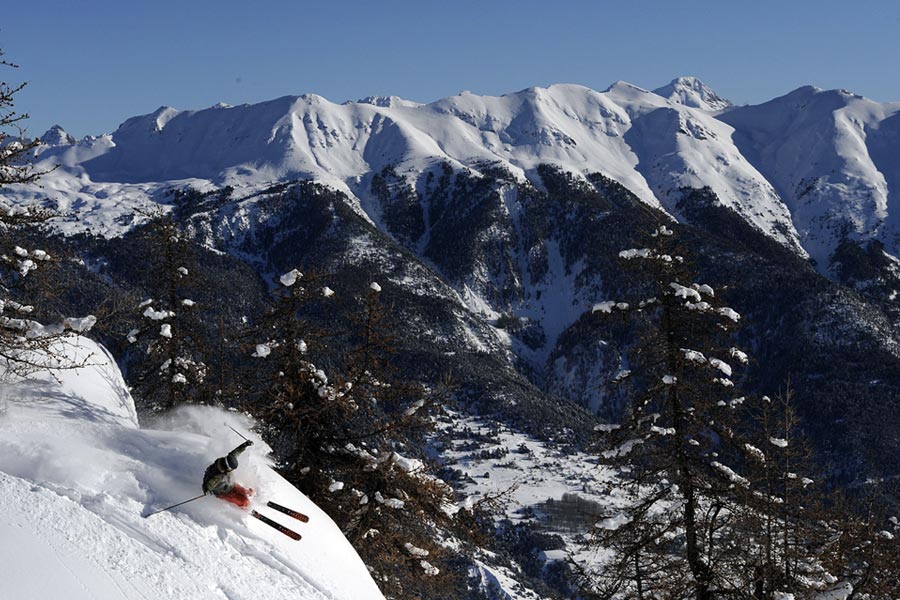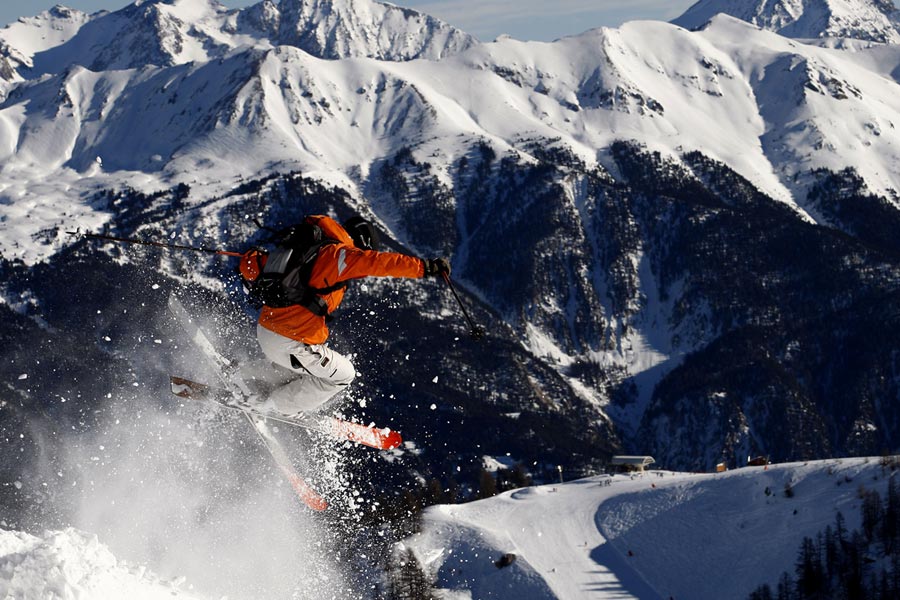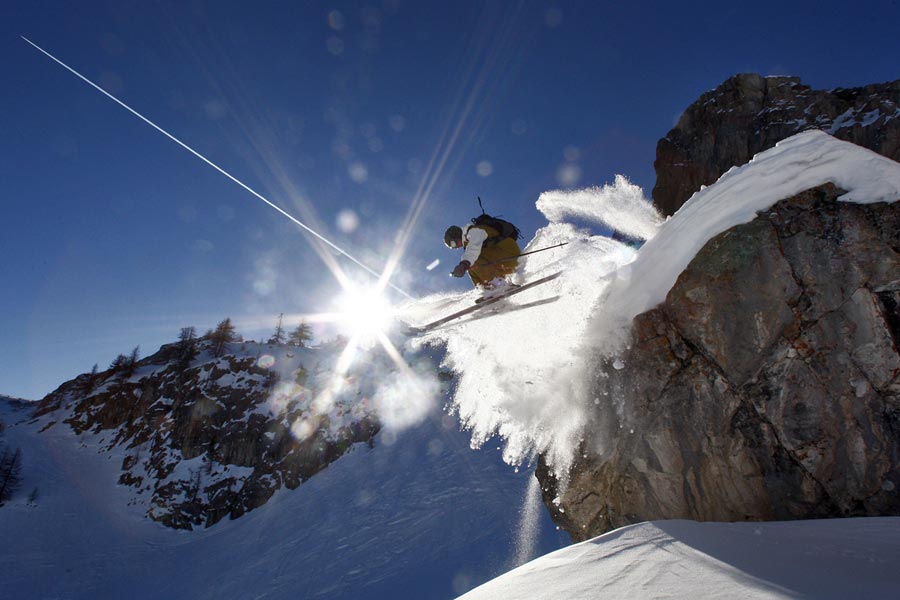- About
- Courses
-
Destinations
EuropeNew Zealand
- Journal
- Contact
Becoming a ski instructor in France is no mean feat. You must first prove yourself as a phenomenal skier by passing a gruelling speed test known as the Test Technique. Our 20 week ski instructor training course in Serre Chavalier prepares you for this very eventuality. Already a strong skier, Cat considered a range of ski instructor courses and decided to give herself the ultimate challenge after finishing university. Here she shares her highs and lows of training in France!
What made you choose this course?
Before setting off for my season, I had no intention of it being anything other than the perfect book-end to my university degree. After the mental stress of studying for four years, the physical challenge (and lack of books) appealed a lot. At first, I was interested in the Canadian courses that Nonstop had to offer, and the intensity of the “Formation”, as it was called, seemed far too daunting. Seven exams later though, and I was sold on a season in Serre Chevalier; you couldn’t get me there fast enough! There wasn’t much skiing to be had in South-West England in May. Now preparing for my second season, my perfect book-end appears not to be doing much ending and I’m more set than ever on passing the notorious Test Technique.
Microsoft.CSharp.RuntimeBinder.RuntimeBinderException: 'Newtonsoft.Json.Linq.JValue' does not contain a definition for 'id' at CallSite.Target(Closure , CallSite , Object ) at System.Dynamic.UpdateDelegates.UpdateAndExecute1[T0,TRet](CallSite site, T0 arg0) at CallSite.Target(Closure , CallSite , Object ) at ASP._Page_Views_Partials_grid_editors_media_cshtml.Execute() in e:\web\nonstop-live\Views\Partials\Grid\Editors\Media.cshtml:line 7 at System.Web.WebPages.WebPageBase.ExecutePageHierarchy() at System.Web.Mvc.WebViewPage.ExecutePageHierarchy() at System.Web.WebPages.WebPageBase.ExecutePageHierarchy(WebPageContext pageContext, TextWriter writer, WebPageRenderingBase startPage) at System.Web.Mvc.RazorView.RenderView(ViewContext viewContext, TextWriter writer, Object instance) at System.Web.Mvc.BuildManagerCompiledView.Render(ViewContext viewContext, TextWriter writer) at Umbraco.Core.Profiling.ProfilingView.Render(ViewContext viewContext, TextWriter writer) at System.Web.Mvc.HtmlHelper.RenderPartialInternal(String partialViewName, ViewDataDictionary viewData, Object model, TextWriter writer, ViewEngineCollection viewEngineCollection) at System.Web.Mvc.Html.PartialExtensions.Partial(HtmlHelper htmlHelper, String partialViewName, Object model, ViewDataDictionary viewData) at System.Web.Mvc.Html.PartialExtensions.Partial(HtmlHelper htmlHelper, String partialViewName, Object model) at ASP._Page_Views_Partials_grid_editors_base_cshtml.Execute() in e:\web\nonstop-live\Views\Partials\Grid\Editors\Base.cshtml:line 20
It's a very challenging course. How did you prepare for It?
So off I went, feeling woefully unprepared after my self-designed training sessions and having just heard that, for the first 3 weeks, every morning began with a 5 km run. Urgh! My training focused mainly on knee strengthening exercises and had slightly neglected actual fitness. Once I’d done twenty-odd single leg squats I felt like a champion athlete and went for a cup of tea. The idea of snapping my ACL on the first day galvanised me just enough to stick to my physio routine but that was about it.

From hiking up snowy mountain tops and avalanche training to basketball and volleyball, we got a chance to try a bit of everything.
Tell us about the first few weeks....
Surprisingly my physical ability when I arrived was not behind the rest of the group. Everyone found the first few weeks challenging (except Clement, a machine who poses as human by day) but when they were over we all missed the variety of the physical prep. From hiking up snowy mountain tops and avalanche training to basketball and volleyball, we got a chance to try a bit of everything. Even sports you had never tried before, you could improve immensely playing one hour a day for several weeks. This was especially true for volleyball when Vincent, our head coach, told me in no uncertain terms that if I didn’t know the rules I was not allowed to play, to which I nodded vigorously having selectively chosen not to hear what he had said. The rules of volleyball are as unknown to me as the finer points of crocheting techniques so when we began, within five minutes, he was gesticulating angrily at me that I had lied to him. By that time the teams were set so I set my mind to learning quickly and by the end of the 3 weeks our team was choir-like in its harmony.
Skiing started in early December (much to our feet’s relief) and we began training every day from Chantemerle, the central village of the Serre Chevalier Valley. Serre Chevalier is the self-proclaimed “sunshine valley”, getting 300 days of sunshine per year. This sounds magnificent until you hear that they define a day of sunshine as any day in which the sun appears at least once. Told like this Scotland would be a veritable Caribbean hot pocket. Regardless it does actually get an inordinate amount of sunshine and bleak days are few, although they tend to come in week-long bursts. Testament to this (or to global warming) is how many afternoons and weekends we spent sunbathing on our roof in February. Glorious times!


What's seasonaire life like in Serre Chevalier?
The resort is huge! Serre Chevalier consists of three towns: Briançon, La Salle les Alpes and Monetier, joined together by hundreds of kilometres off-piste and what feels like 80 villages. Our shared house was in Briançon, at the southern end of the valley and we usually began our days at Chantemerle, one of the many villages around La Salle. Monetier, renowned for its off-piste, was more rarely our starting point, but from what I gather that varies hugely from season to season.
With 10 of us living in such a busy and exciting house, we luckily didn’t need a lively night scene right on our doorsteps. Although Briançon is a “proper” town, with all the amenities one needs, it only has a couple of bars. It does however have some wonderful cafes in which we whittled away most of our Sundays. We hosted a lot of get-together's for the people on our course, French and English alike, and Chantemerle is full of bars with a late-night bus that could get us home if we timed it well. If we didn’t, it wasn’t unheard of to end up kipping in the local boulangerie that opened at 4am.
What was the toughest part of the training?
Although our ski training began early December, slalom training didn’t begin until our first day back after the Christmas holidays. Primed and ready after our free-skiing training (with our brand new slalom skis) we were all excited to try out the real deal. None of us really had an idea of what to expect, although we knew from 2nd year students that our expectations of our own ability should be at least at rock bottom, and preferably below. The first day of training in full-sized slalom gates was an odd mixture of terrifying and hilarious. In awe, we watched our coach, Val, dance down the track, hovering above the snow, effortlessly batting away the plastic poles as if they were nothing. As if they wouldn’t crack his goggles or leave welts on his arms if they clipped him. “Just protect yourself!”, was Vincent’s reassuring advice when we asked him what we should do with our hands, “after they hit you, you will learn".
We had already trained a fair amount on small poles, ‘stubbies’, that come to just below the knee, but it didn’t prepare us for the challenge of trying to maintain a good turn with a hard plastic pole flying at your face every half a second (2 seconds at the beginning, let’s not big ourselves up). Despite the struggle, we thoroughly enjoyed getting our teeth into what slalom really was, and our days began to take a more regular format that we were to follow for the rest of the season.
HOW DID YOU PREPARE FOR THE TEST TECHNIQUE?
Either it snowed, and we went gallivanting around with the coaches, trying only to keep up as they bombed down every interesting piece of off piste Serre Chevalier had to offer (if everything close-by had been skied, the menu was a half-hour hike before chasing them down the mountain); or we were setting up the gates in the morning before doing a morning training session. They always put up different length and style of tracks to try and get us used to every type of turns. Their ethos was that for a great skier, every turn should look the exact same despite an ever-changing terrain, and they sure made us live it. After the morning, we would either do some on piste free skiing, aka technique training, or another session in gates. The coaches believe very strongly that one can become “slalom-saturated” and tried their best to avoid that.


What was the Test Technique Like?
After 3 weeks of slalom training, it was time for our first test. Having been out for almost a week with a spasming back, I didn’t hugely fancy my chances and I remember being in quite crippling pain as I took the button lift to the top of the track. Nevertheless, I gave it a go. True to form, I flew out on the 4th gate (much to my own amusement if no one else’s). My second run was marginally better, I reached the bottom in a fairly considerable amount of pain and a sorry 11s after the time.
Despite my very pathetic run, race day was one of my favourite days of the season. The atmosphere was such a jovial one; one of the French guys hired a van and we all piled in, stopping for drinks on the way home in some lost, little mountain village. I remember something that really struck me when a French friend was telling me about why he’d never gone into ski racing as a child (he was, instead, very talented freestyle skier). Born and bred in Briançon, it would have been completely natural for him to try racing, certainly passing his test as soon as he was eligible to sit it. He said the mentality of French ski racing, as an institution, was something he’d never wanted anything to do with, even as a child. They push and push the children and imbue them with a sense of entitlement; they teach them to be arrogant and think of themselves only as a solo player, despite technically being in a team.
This could not have been more different with the Formation. At every race, you had every available person screaming for you as you crossed the finish line. People whose hearts were set on passing but who, crushingly, missed it by tenths of a second were back the next day putting all their support behind their teammates, in the genuine hope that they would get the time. Without a doubt, it was this atmosphere of support and affection that has persuaded me to come back and give it another go.
Start Your Instructor Journey
Begin your own instructor journey with our ski instructor courses or snowboard instructor courses.
We look forward to speaking with you.